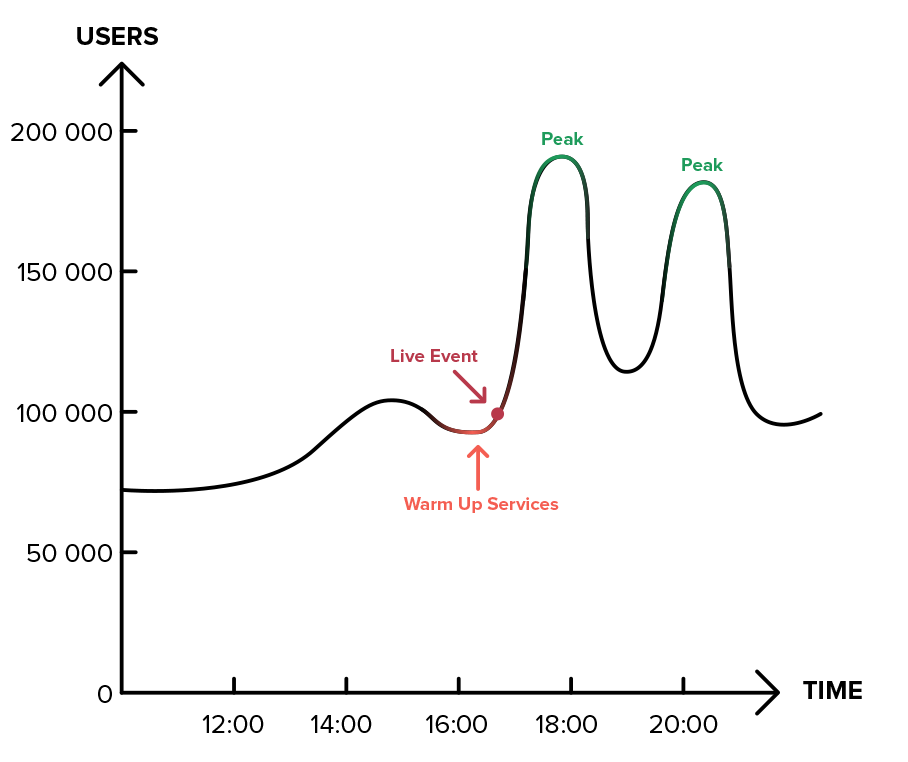Sports OTT: Live Sports Streaming & Video Delivery
You just won the exclusive rights for a highly in-demand football league and are looking to stream the games live for your fan base. Question is, do you have the technology platform for sports OTT to make it a success as your fan base starts to grow and incoming demands increases?
In this blog post we look in detail at the technical requirements you need to consider for sports OTT, and share how at Magine Pro we enable our partners to deliver high quality, low latency streams to audiences around the world.
Media quality & low latency
There are many technical aspects to consider when providing a premium OTT service for sports, and in particular live sports where quality is of the utmost importance. With fast-moving objects, a high bit rate for High Definition from 720p and more is essential with 60 frames per second. This is preferable for big-screen viewing as with 60 frames per second, the transition between each frame is much smoother, which makes fast-moving sports content look frictionless as a result. And as it stands today, anything over 60 frames per second will not make the viewing experience any better.

Key areas to consider & address include:
- Assess what effect media ingestion (encrypted transfer), encoding and packaging, and the network have on latency overall
- The choice of media segment lengths
- Using HTML5-friendly streaming technologies as HTTP Live Streaming (HLS) or Mpeg-Dash to give cacheable delivery
- Content delivery networks (CDNs) that can deliver higher volumes with more efficiency
- How the player handles buffering
 Content Security
Content Security
Content owners will invest a lot of resources acquiring media so that they can offer their users the latest live events and an attractive VOD catalogue. Most right holders today also require a certain level of security protection in an OTT platform to be able to acquire content from them. Protecting media from being accessed by unauthorised users involves utilising different tech and methods.
One method is Digital Rights Management (DRM), which can control the distribution of copyrighted works. Before content is streamed it must be encrypted and packaged with a DRM schema so that only authorized users and devices can play it back. At Magine Pro we use Microsoft PlayReady, Google Widevine and Apple Fairplay to do this. We can also enforce DRM key rotation in a given interval to take down any ongoing streams that might have been set up in an untrustworthy way.
The content license agreement you have with the right holder may also specify locations that are unauthorised to access content. Because of this, in addition to DRM protection, right holders also request that OTT platforms deny users access when connecting through banned VPN or Proxy services. At Magine Pro we provide all of the mentioned security techniques above to our partners.
You may also need to look at reducing the number of ongoing streams and devices per user account to maximise revenue intake and eliminating account sharing. This is particularly important when hosting exclusive live events in your service.
Scaling for demand
As your OTT service expands over time you will need to scale to avoid certain drawbacks, including loss of video quality, poor user experiences and increased costs affecting you and your customers. This can be challenging if you haven’t done the engineering work or built in the relevant monitoring.
At Magine Pro we run our OTT platform on AWS, which enables us to scale up and down as we require and pay only for what we use. Working with AWS also means during peaks we don’t need to set an upper user limit or traffic limit because of hardware constraints. This is a big advantage for us and our partners that we build OTT services for.
In an ideal world, you would be able to scale up when demand increases and scale back down when traffic decreases. Sounds easy, but services often require a warm-up before they’re ready to accept incoming requests and traffic. Autoscaling is good, but not great at this.
For live events, especially for pay-per-view, you should pre-provision your infrastructure to manage the exponential rise in traffic when the event starts. Autoscaling often takes many minutes to kick in, however, so it’s better to provision more, and scale down, than not scale up quickly enough.
With pay-per-view events, typically you know how many people have pre-purchased before the event, this early indicator lets you know how much you need to scale. However, you could also see an increase in purchases up to 10-15 mins before the event starts, so you need to build in some headroom to handle that. It can be a good idea to run a pre-event (especially if you haven’t delivered live before) to ensure payment flows are provisioned to handle a potential increase in traffic right before the event begins.
Your service operations team also plays an important role when hosting live events. It’s essential to have clear roles and responsibilities in place and also defined escalation paths, communication & troubleshooting routines between the event distributor and your platform provider.
Service testing & reliability
As an OTT platform service provider, we strive to have high reliability. To achieve this, we need to consider the architecture for high availability, what infrastructure and how we utilize AWS’s cloud infrastructure.
High availability requires more resources, which can compete with our aim for low latency (affected by the number of steps in the end-to-end flow). At Magine Pro, we provide flexibility here for our partners. They can select resiliency levels depending on the value of their content, audience size, live vs Video-On-Demand or accepted down-time.
The starting point is to look at multiple incoming signal paths; from the signal distribution (even down to power suppliers), all the way through to acquisition, transcoders, automatic failover and monitoring tools. Doing this enables us to achieve resiliency and to withstand certain types of failure, yet remain functional from the customer perspective.
Understanding our platform and our partner’s availability needs enables us to design and continuously test our platform using injection patterns. We can take down services to learn how the platform reacts and remains functional from the customer perspective. In this case, we also have simulated end-users or real users in a production environment.
You might think you have high reliability and resilience to handle services going down, but without really testing it you don’t build up a confidence level. We do this testing continuously and monitor the outcome to improve our engineering capabilities, to better handle failures, start-up new services, and to re-balance traffic over to healthy endpoints.
_______________________________________________________________________________________
To find out more about our OTT platform and how we enable our partners to deliver live events, linear and VOD content to audiences around the world head here. On our experience page, you can find out more about our partners and the OTT services they operate.
Get in touch with us if you would like to discuss how we can help you launch a successful sports OTT service or to demo our services.
You can also subscribe to the Magine Pro e-newsletter and/or follow us on LinkedIn to stay up-to-date with our latest news, partners and products.

